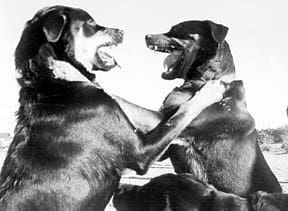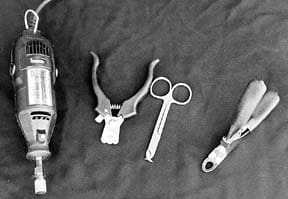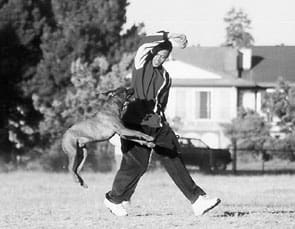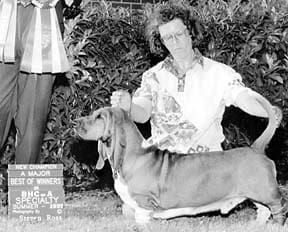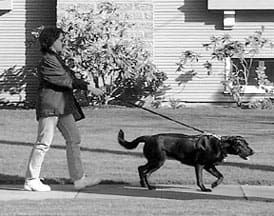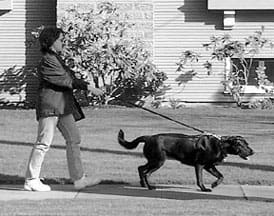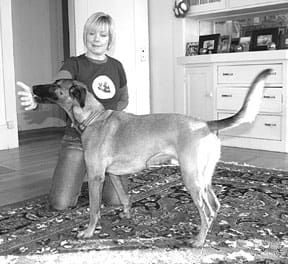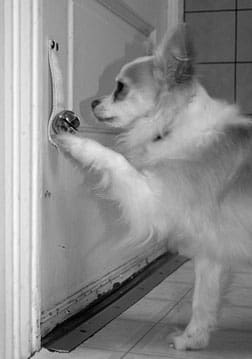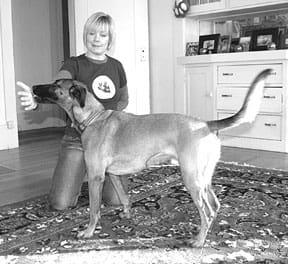[Updated November 16, 2017]
Dogs fight other dogs for many reasons. They fight in aggressive play. They squabble over food and toys. They challenge each other for the best spot in the pack or the best spot on the bed. They fight to protect their puppies and other canine pack members, or to defend territory and their humans. Some fight because they’ve been bred or taught to fight. And a surprising number of dogs fight just because they are poorly socialized; they’ve never learned to speak “dog,” and as canine social “nerds” they inadvertently display body language that triggers aggressive responses from other dogs. Serious dog-on-dog aggression is a common problem, and one that is often overlooked and too often tolerated. However, it is not normal dog behavior, and it can, in many cases, be prevented or mitigated.
All dogs are capable of turning on one of their canine acquaintances with a short but ferocious attack. If this happens only occasionally, these brief (though dramatic) interchanges are actually normal – a device that dogs use to set boundaries regarding what kind of behavior they won’t tolerate, or to establish dominance over each other. But dogs that frequently attack other dogs without regard to the victim’s behavior can cause us a lot of trouble, heartache, and even lawsuits.
A tiny percentage of these canine bullies are born, not made; certain breeds were developed to fight each other. But far more dog-aggressive dogs were made that way by their owners – through a lack of proper socialization, inappropriate human intervention in normal canine interactions, and even encouragement of aggressive behavior. In other cases, a dog slowly develops increasingly aggressive behavior that goes unchecked or unnoticed by his owner – at least until it gets bad enough that the dog seriously injures someone else’s dog.
It’s very frustrating for social, responsible dog owners when they end up with a dog who can’t get along with other dogs. Understandably, few people want to walk with them. The walks they do take are fraught with tension, as they try to control their dog and warn other owners to keep their distance. Eventually, many people tire of the stress, and dominant canine bullies end up exiled in back yards, or even put to death.
Help Your Dog Regain Social Access
Fortunately, with appropriate training, many of these social misfits can regain access to society. Some trainers, including myself, occasionally offer special classes for such dogs. These “Growl” or “Difficult Dog” classes are designed to teach owners new skills for dealing with their dogs’ antisocial behaviors, and to give the dogs the opportunity to learn appropriate social skills.
One goal of the class is teaching owners how to detect and interpret their dogs’ aggressive body language in time to avert confrontations with other dogs. They learn exercises that can distract their dogs from their habitual and aggressive focus. The owners also learn to use food lures, rewards and praise to reinforce desired behaviors.
The other major goal is to give the dogs opportunities for learning appropriate dog social behavior from each other. In the wild, dominant body language is most frequently used to avoid fights, since it is contrary to pack survival for dogs to go around routinely injuring each other. Most dominance moves – snarls, raised hackles, chin over shoulders – are bluffs, designed to intimidate the opponent into bloodless submission. Occasionally, a brief scuffle may ensue, rarely causing serious injury. Thus dominance in wild packs is usually settled and maintained with relative non-violence. Owners of domestic dogs tend to be phobic of any display of aggression between dogs. Because of the perceived risk of serious injury to the participants, owners don’t let dogs “fight it out” in an uncontrolled setting, so most dogs never experience the natural consequences of their aggressive behavior. Therefore, minor, normal and usually harmless scuffles are often treated as major crises. The dogs are yanked apart and punished mightily. As a result, not only do the dogs not learn how to settle their squabbles peacefully, their levels of stress and aggression actually escalate and they become more aggressive around other dogs. It becomes, literally, a vicious cycle.
In a Growl Class, dogs can be allowed to interact to the point of learning those consequences – with an important difference: they wear soft but strong muzzles. In this controlled setting, dogs safely get past their initial burst of aggression so they can get to the part where they learn to relate appropriately.
It’s critical that dogs and owners enrolled in these classes are pre-evaluated by the trainer. Classes are then custom designed to meet the needs of the students. Protections are put in place so that big bullies are prevented from trouncing the timid dog who bites in self-defense. Where appropriate, owners can be shown some of the exercises ahead of time so their dogs get extra practice. A bully might need to spend more time practicing his “Off” exercise, while a very nervous dog might get extra homework assignments in “Relaxation Techniques.”
By the end of the course, some dogs can be fully integrated into their local canine community. Others can be given supervised freedom in a designated “play group.” Still others will never be trustworthy for off-leash play, but will be under much better control and far safer on-leash than previously.
The best results will be enjoyed by highly motivated owners who enjoy close bonds with their dogs. Dogs who are responsive and connected to their owners and who are easily motivated by food, praise or other rewards are most likely to benefit from this type of class. Independent dogs who are oblivious to their owners’ presence and behavior requests are more likely to fail.
A Typical Difficult Dog Class
The mix of people and dog personalities (and mixed results) displayed in one of my recent Growl Classes was fairly typical. I offered the class in Santa Cruz, California, late last summer, and after fielding lots of inquiries from owners of dog-aggressive dogs, I selected four to participate: Beau, an eight-year-old neutered male Rottweiler mix; Kito, a three-year-old neutered male Akita; Jessie, a four-year-old spayed female Australian Cattle Dog mix, and Schmaal, an eight-year-old spayed female Saluki.
These selections were made on the basis of my careful pre-evaluations of each potential member of the class. Jessie was an overachieving, slightly fearful herding dog who was strongly driven to protect her owner from the mere presence of other dogs. Schmaal was a graceful, athletic sighthound, who routinely responded to other dogs with aggression, though the stress of a training class made her act aloof, almost to the point of catatonia. Her stress level was so high in class, in fact, that getting her to eat treats was a major accomplishment.
Kito the Akita was previously abused and had been attacked by dogs before; he seemed to go on the defensive with other dogs due to apprehension about being attacked. In general, it seemed he had a lot of issues to sort out. Beau, however, was my greatest concern. He had been attacking dogs all of his life, enjoyed being a bully (all 120 pounds of him), and was on a restricted diet due to problems with his digestive system. He had also previously been through punishment-based training to try to control his aggression.
Food is an important part of a successful Growl Class. Instructors use positive methods to reduce the dogs’ stress and to teach them that having other dogs around is a “good” thing. This cannot be accomplished with punishment, only with reinforcement and reward. Since food is a primary reinforcer that can be delivered quickly and easily, its use is critical in getting a dog to think positively about a stimulus (in this case, the presence of other dogs) that has previously been perceived as a negative.
In this particular class, the use of food as a reward was problematic for two of the dogs (Beau had digestive problems, and Schmaal was too stressed to eat). I warned the owners in the class that this would present us with additional challenges.
Growl Class Session 1
I do not allow the dogs to interact in the first session of a Growl Class; we practice exercises and assign homework so that the dogs are more responsive to their owners before the first interaction in Class #2. We start out with students and their dogs spread out around the training area – with as much distance between them as is possible. People and dogs are seated on blankets or rugs on the ground.
I start the first class with an in-depth discussion of dog behavior, aggression, and canine body language. Each owner describes his dog’s history of aggression, and the kind of behavior he anticipates from his dog in the class setting. We analyze the body language that each of the dogs displays, discuss its likely meaning, and make predictions about the dogs’ behaviors during their interaction to come. It is important from the very beginning of the first class that owners begin to develop their skills in reading dog body language so they know when and how to intervene appropriately.
Next, I invite discussion from the owners regarding their feelings about their dogs and about the class. It is normal for owners to be apprehensive. I explain that we wouldn’t let the dogs hurt each other, and that one goal of the class is to allow dogs to interact safely so that they can learn appropriate body language and social behavior around each other.
Then, we began to work with the dogs. Unlike my regular classes, where I am upbeat, speak cheerfully, and move quickly, Growl Classes are almost like meditation sessions. The first exercise is intended to lower the stress levels of dogs and owners by doing relaxation exercises – massage on a rug or blanket for the dogs, with deep breathing for the owners.
Next, dogs and owners learn an “Off” exercise (see link below for all exercises), which means that if they give a “hard glare” to another dog they are asked to “Off” and are given a Click! and treat when they look away from the other dog. They can also get clicks and treats for “soft” glances (and tail wags!) at other dogs, and lots of clicks and treats for paying attention to their owners. The purpose of this is to teach them that the presence of other dogs is a good thing – they get lots of treats when other dogs are around.
As I had anticipated, Beau had the most difficulty with this critically important exercise. Not only was he very committed to the hard stare that signals the pre-launch phase of an all-out attack, but the treats his owners used – his regular dinner kibble – were not nearly attractive enough to distract him from his seek-and-destroy missions. We finally began to have some success with Beau in Week #4, when I started rubbing meaty treats on my hands and letting him lick the flavor off as his reward.
Another exercise taught in the first class is the “Gotcha!,” a positive cue (with treat reward) for a grab on a dog’s collar, which becomes necessary when we need to intervene in a scuffle.
Next, we practiced fitting muzzles on the dogs, and did a little calm, one-at-a-time leash walking around the training area, while owners practiced their tone of voice (calm and upbeat, not panicked or commanding) for use with the “Off” cue. We ended with more relaxation and discussed how everyone felt about the class so far. I instructed dog and owner pairs to leave calmly, one at a time, to avoid confrontations at the door.
Growl Class Session 2
I start and end every class from the second week forward with the relaxation exercises learned in the first class. My group of four responded well to these exercises, and we got settled quickly. Then I had the owners put the muzzles on and do some calm on-leash walking/attention exercises. At first, I had three dogs sitting and just one walking, while getting lots of positive reinforcement from her owner for calm behavior as she passed the other dogs. Then we did “pass-bys,” where two dogs pass each other walking on leash, again with lots of treats for good behavior. The challenges of Beau’s and Schmaal’s food restrictions became apparent early in this exercise.
After the relaxation and leash exercises, we conducted the first off-leash interaction. I checked each of the dogs’ muzzles for comfort and secure fit, while we discussed the rules. I explained that I would tell the owners when to release their dogs, and that they should simply stand back out of the way. Confrontations between the dogs would be likely, but the muzzles would prevent injury.
The first off-leash interaction was a high anxiety time, for me and the owners. I felt my adrenaline build, and disciplined myself to keep my voice and body language calm. “If there is a problem,” I cautioned my students, “let me handle it. If I need help I will ask for it. We all took several deep breaths, and then I told them to release their dogs.
First (Muzzled) Dog-Dog Interaction
Surprisingly, little Jessie was the first aggressor. She flew out from behind her owner at Schmaal, who wandered by too closely. This started a free-for-all, with the most intense aggression, as expected, between Beau and Kito. Jessie and Schmaal disengaged fairly quickly, while Beau and Kito trounced each other for several minutes before calling a truce.
We all breathed a sigh of relief. The dogs wandered around the training area, glaring but not attacking. We then called the dogs, rewarded them, put their leashes back on and removed the muzzles, and settled down for more relaxation and debriefing. Yes, it was scary, but it was a relief to see that the muzzles worked, and that the fighters stopped quickly, and of their own accord.
However, I explained that in the next class, we would not allow the fighting to continue to its own conclusion. We would use our “Off” interrupter to try to intervene pre-launch (with a big click and reward if the dogs succeeded), and our “Gotcha” to intervene post-launch if necessary. I instructed the owners to practice “Off” and “Gotcha” for at least 20 minutes per day, so that, hopefully, the dogs would attain a high level of responsiveness by the next class.
Growl Class Session 3
In the third week, Jessie’s owner reported that Jessie was making great progress. She was passing other dogs on the street without giving them the evil eye, and was responding nicely to “Off” and rewards. Schmaal, also, was doing surprisingly well. Although she still disdained treats in class, she would eat them out in the “real world.” However, I had concerns about Beau and Kito. Even during relaxation exercises Beau glowered at Kito from the opposite corner of the room. Despite my pleas to Beau’s owners to find some other kind of high value treat, they still fed him only kibble.
We warmed up with by-passes; Jessie and Schmaal got to do theirs without muzzles. Then, with all four muzzles on, we tried for some controlled interaction. The dogs were released. Beau and Kito launched for each other; Jessie and Schmaal wanted to join in but responded to their owners when called back. Lots of rewards for that!!! Meanwhile the two big bruisers seriously went at it. We looked for an opportunity to intervene with an “Off” and a “Gotcha” and retired to our relaxation rugs.
Next, we gave Jessie and Schmaal an opportunity to interact together without the boys. Muzzles on, there was only a brief threat from Jessie that was over almost before it began.
Growl Classes 4 and 5
Kito didn’t show up for the next class. Since they hadn’t called me, I couldn’t know if it was because his owners were discouraged or if it was due to an unrelated scheduling conflict, but it was disheartening, and it put a crimp in our program. We did our basic exercises with the three remaining dogs, and tried an off-leash interaction with all the dogs muzzled. Beau behaved well with just the girls present. I showed his owners how to rub meat flavoring on their hands and the kibble treats, to get Beau more engaged in the reward process. It seemed to work for the wife, who learned to combine the treat reward with upbeat verbal praise. Beau still ignored the husband’s boring treats and monotone voice, however.
This session went so well that after the three-dog interaction we put Beau back on his relaxation rug, and removed Jessie and Schmaal’s muzzles. With calm, relaxed off-leash walking, owners nearby, both dogs did beautifully. Jessie was aware of the other dog but she stayed under control; Schmaal just pretended Jessie wasn’t there. We all agreed that Beau was not ready for off-leash interaction without his muzzle.
Kito returned for the fifth class, which seemed to renew the animosity between the two big males. Beau would not respond to his “Off” and “Gotcha” exercises, and the off-leash interaction between the two was not productive; Beau simply wanted to bully Kito unmercifully. We tried removing Kito from the training area to repeat the previous week’s success with Beau and the two girls, but he was too aroused from his interaction with Kito, and jumped on Jessie. For the two boys, the focus for the rest of the classes was on “on-leash” behaviors.
Jessie and Schmaal continued to progress with off-leash and off-muzzle work. Jessie’s owner became adept at reading Jessie’s body language and pre-empting any kind of scuffle with the “Off” cue.
The Final Difficult Dog Class
Kito’s owners called me to say that they had enjoyed the class and felt Kito benefited, but they wouldn’t be attending the last session due to scheduling conflicts. I was disappointed – I thought Kito had much more potential than he was allowed to develop.
As the rest of us began our last class with relaxation exercises, we talked about our goals and how we felt the dogs had done throughout the class. We agreed that Jessie was the star of the class. She was just the right type of dog to benefit the most from a Difficult Dog class – bonded to her owner, food motivated, responsive, and committed to doing her job. She just needed to have her job description rewritten slightly. Her owner, Melanie, reported that while Jessie was not yet 100 percent reliable around other dogs she was much improved. Melanie is confident in her own awareness of canine body language as well as her improved control over her dog to take Jessie places and give her considerably more freedom than she would have in the past.
Stephanie, Schmaal’s owner, was pleased with her progress. While she was nowhere near ready to turn Schmaal loose on the beach with a pack of dogs, she was much more confident in her ability to get Schmaal to respond to her when necessary.
Beau was my biggest disappointment. At Week 6 he was still looking for someone to bully. His eight-year history of dog aggression, along with his owners’ failure to find a suitably enticing reward, proved to be insurmountable obstacles. While he was marginally better behaved on leash around other dogs, and did respond to the relaxation exercises, Beau still had a long way to go.
Growl Classes will continue to be one of my training offerings; there is a crying need to help dogs remember how to be part of a pack. The shame of dog-aggressive breeds, poorly socialized pups, and dogs encouraged or allowed to be aggressive with each other, is our failure. This is a species designed to live and work together in relative harmony, and we have botched the plan. But for many dogs it is not too late. If you have a dog who wants to eat other dogs for breakfast, find your nearest positive reinforcement trainer (who will use treats, praise and other rewards rather than choke or pinch collars) and ask for assistance. If you’re lucky, she may start a Growl Class soon.
Click here to view the dog exercises.
Pat Miller, a freelance writer and dog trainer, is a frequent contributor to WDJ.


